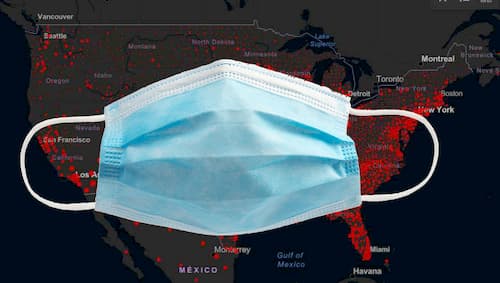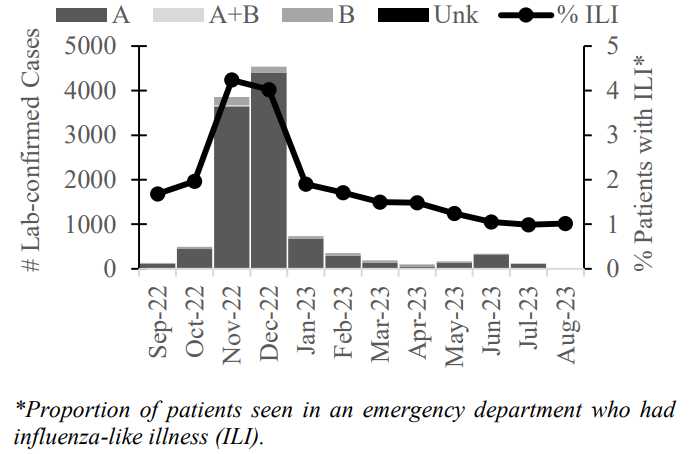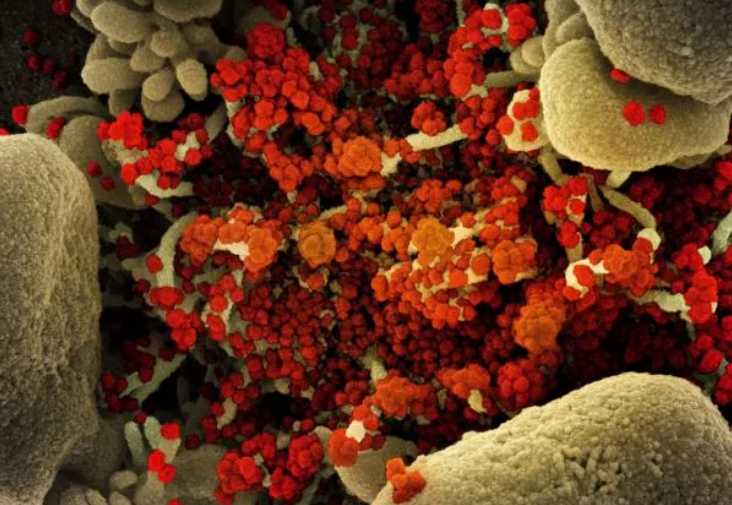-
COVID-19 transmission continued to occur in most parts of Alaska during the week of November 27 – December 03, 2022. There is no clear overall trend.
-
The number of patients hospitalized with COVID-19 has been generally stable over the past few weeks (see graph below illustrating hospital beds occupied by persons with COVID-19). Most parts of Alaska are at the “low” COVID Community Level as defined by CDC. Learn more about CDC’s recommended prevention steps at each community level here.
-
Influenza activity in Alaska continued to increase last week. We are seeing more influenza earlier in the year than we have in past seasons.
-
Now is a good time to receive an annual influenza vaccine and a COVID-19 booster shot. Visit vaccines.gov to find your COVID-19 booster and influenza vaccine. Bivalent COVID-19 booster vaccines are recommended for everyone ages 5 years and older who completed the primary series or received their most recent booster dose at least 2 months ago. COVID-19 and seasonal influenza transmission is now occurring in many Alaska communities. See the updates section for more information.
-
Docket is a free app that provides easy access to official vaccination records. You can download and carry a digital copy of your records anywhere at any time. For more information visit vaccinationrecords.alaska.gov.
-
People with symptoms of COVID-19 should get tested immediately. Those who test positive should notify contacts who may have been exposed. People with COVID-19 should isolate for at least 5 full days after their symptoms start (or positive test result in asymptomatic people) and wear a mask after leaving isolation. See CDC guidance on isolation for details. Treatments are available for people at higher risk of severe disease. See the updates section below for more information.
-
People who have been exposed to COVID-19 should wear a mask for 10 full days and get tested at least 5 full days after exposure. Learn more about what to do if exposed. CDC no longer recommends quarantine of exposed persons in most settings, regardless of vaccination status.
-
Respiratory viruses circulate year-round in Alaska. Actions such as staying home when sick, washing hands, and improving ventilation can protect you, your family, and your community from COVID-19, influenza, and other infectious diseases. See an Alaska Public Health Alert Network message from September and a CDC Health Advisory from November for information on a variety of respiratory viruses.
COVID-19
COVID-19 Case Trends
-
COVID-19 transmission continues to occur in many communities across Alaska. There is no clear overall trend.
-
Cases appear to have increased modestly over the past few weeks in the Municipality of Anchorage. There are not clear, sustained trajectories in the Matanuska-Susitna Borough, Fairbanks North Star Borough, Kenai Peninsula Borough, or City and Borough of Juneau.
-
The intensity of COVID-19 transmission varies between communities outside the largest boroughs. In most instances, the number of reported cases is low without a discernible trend. Making comparisons between communities is difficult because testing practices may vary between communities. Even if cases are not reported from a location, there might still be community transmission occurring. While many infections with the virus that causes COVID-19 are not detected or reported, changes over time in the number of reported cases still provide useful information about the trajectory of the pandemic.
-
COVID-19 cases continue to occur in many communities in Alaska off the road system, with some communities experiencing large numbers of cases relative to their population size.
-
BA.5 (a type of Omicron) and its sub-lineages are dominant in Alaska, though BA.4 has also been detected in recent weeks. Some of the sub-lineages of BA.5 that have increased in frequency in the United States and that are being tracked by CDC have been detected in Alaska and in the most recent data account for a larger proportion of sequenced viruses. These include BQ.1 and BQ.1.1. Visit Alaska’s SARS-CoV-2 Genomics Dashboard to learn more.
-
To learn more about COVID-19 cases, hospitalizations, and deaths in Alaska, visit the Cases Dashboard.





